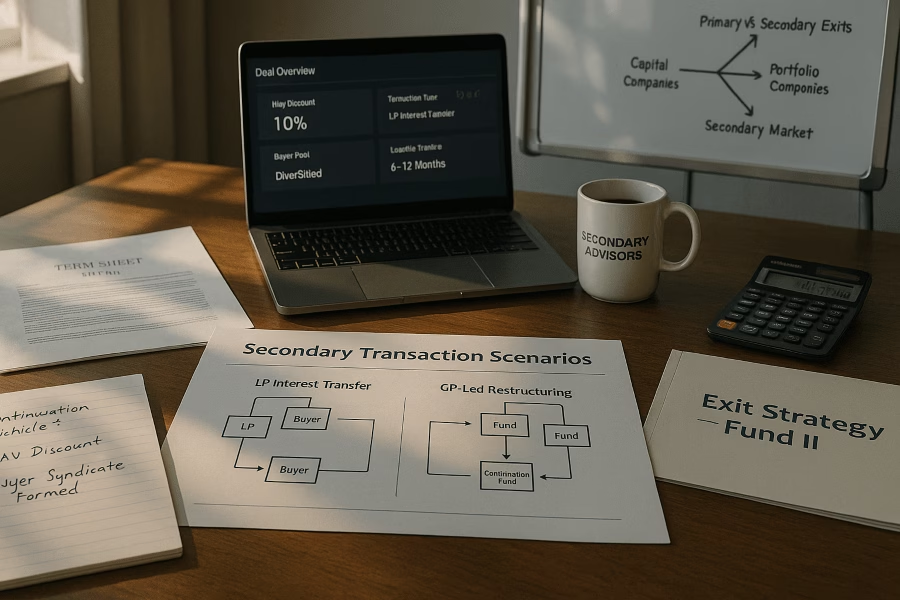Private equity secondaries have emerged as a vital mechanism for investors seeking liquidity or exit strategies in an otherwise illiquid market. These transactions involve the resale of existing private equity stakes, offering flexibility to both buyers and sellers. Whether you're an institutional investor or a startup founder, understanding secondaries can unlock opportunities to optimize your portfolio or secure capital.
The discussion on how to find investors for startups provides a comprehensive framework that sets the stage for exploring liquidity options and exit paths in private equity secondaries.
This blog will delve into the types of private equity secondary transactions, their benefits, and actionable insights for navigating this dynamic market.
What Are the Different Types of Secondary Transactions?
Secondary transactions in private equity offer diverse pathways for liquidity and portfolio optimization, catering to both limited partners (LPs) and general partners (GPs). These transactions fall into three primary categories: LP stake transfers, GP-led deals, and direct secondary sales. Each type serves distinct strategic purposes within the private equity secondary market.
LP Secondary Transactions
LP stake transfers are the most traditional form of secondary transactions. In these deals, limited partners sell their stakes in private equity funds to other investors, often seeking liquidity or portfolio rebalancing. For buyers, this can be an opportunity to acquire mature assets at potentially discounted valuations. According to Buyers Market, certain periods, such as 2021, have created favorable conditions for secondary buyers, highlighting the cyclical nature of this market. LP transactions are straightforward and typically involve fund stakes across multiple assets, making them a popular choice for institutional investors.
GP-Led Transactions
GP-led deals have gained significant traction in recent years, offering general partners the ability to restructure or extend the life of portfolio assets. These transactions often involve continuation funds, where existing assets are transferred into a new vehicle under revised terms. A notable example is the Edison Partners Continuation Fund, which illustrates how GPs can retain control while providing liquidity to existing LPs. Interestingly, 48% of continuation fund activity in 2024 is expected to focus on single-asset vehicles, underscoring the growing preference for targeted strategies within GP-led processes.
Direct Secondary Transactions
Direct secondaries involve the sale of individual company shares, often by founders, employees, or early investors. These transactions are particularly common in late-stage startups seeking liquidity before an IPO. For instance, Robinhood’s auction-style secondary demonstrated how creative liquidity solutions can address pre-IPO funding needs. Direct secondaries offer flexibility and can be tailored to meet specific liquidity goals, making them a valuable tool for startup ecosystems.
Understanding these transaction types is essential for aligning investor profiles with strategic objectives. A deeper dive into investor mapping fundamentals reveals how identifying the right investor profiles can enhance engagement in secondary transactions.
How Secondaries Bring Liquidity and Boost Returns
Private equity secondaries have emerged as a dynamic solution for unlocking liquidity while enhancing returns for both sellers and buyers. These transactions offer a strategic pathway to mitigate risks, accelerate cash flow, and optimize portfolio performance.

Unlocking Liquidity for Sellers
Secondary transactions provide sellers with an opportunity to access liquidity without waiting for traditional exit events. By selling their stakes in private equity funds or direct investments, sellers can free up capital for reinvestment or other financial priorities. The global private secondary market volume is projected to reach $162 billion in 2024, showcasing its expansive potential for liquidity and returns.
Accelerating Returns for Buyers
For buyers, secondaries offer a unique advantage: faster returns. Unlike primary investments, which often experience delayed profitability due to the J-Curve effect, secondary investments involve acquiring mature assets with established performance histories. This reduces the waiting period for returns and enhances portfolio efficiency. With $216 billion in dry powder among secondary buyers projected by 2025, the market is well-positioned to facilitate liquidity and drive returns.
Mitigating Risks with Prior Performance Data
Secondary transactions also reduce blind pool risk, as buyers can evaluate prior performance data before committing. This transparency allows for informed decision-making and minimizes exposure to underperforming assets. A review of how to prioritize investors sheds light on the methods for targeting outreach efforts, thereby complementing the strategic evaluation of exit opportunities in the secondary market.
What Is a Secondaries Fund and How Does It Work?
Secondaries funds offer a unique approach to private equity investing by focusing on acquiring existing stakes in private companies or funds, rather than investing directly in new ventures. Unlike primary private equity funds, which allocate capital to startups or early-stage businesses, secondaries funds purchase interests from existing investors looking to exit their positions. This strategy provides an alternative pathway for investors seeking exposure to private equity markets while mitigating certain risks.
One of the key benefits of secondaries funds is diversification. By acquiring stakes across multiple companies or funds, these investments spread risk more effectively than traditional private equity models. Additionally, secondaries funds often come with lower fees compared to primary funds, making them an attractive option for cost-conscious investors. Another advantage is earlier liquidity; since secondaries funds invest in mature assets, investors may see returns sooner than they would with primary funds, which typically require longer holding periods.
For those interested in the legal considerations surrounding secondaries funds, the Latham practice provides valuable insights into structuring and engaging in these investments. Understanding these aspects can help investors make informed decisions and navigate the complexities of the secondary market.
To further explore how geographic factors influence secondary strategies, an analysis of local vs global investors pros cons introduces a balanced perspective on liquidity strategies and exit paths. This context highlights the importance of aligning investment goals with the fund’s location and investor base.
Your Guide to 2024 Trends in Private Equity Secondaries
The private equity secondaries market is poised for transformative growth in 2024, driven by technological advancements and evolving investor dynamics. As institutional and retail interest in secondaries expands, several key trends are reshaping the landscape.
AI-Driven Due Diligence Adoption
Artificial intelligence is revolutionizing how secondary opportunities are evaluated. By incorporating advanced analytics, investors can now process vast amounts of data with greater speed and precision. This innovation reduces the time required for due diligence while enhancing decision-making accuracy. For more insights into how AI is streamlining private equity processes, explore AI-driven due diligence adoption.
Retailization Through '40 Act Funds
The secondary market is becoming increasingly accessible to retail investors, thanks to the rise of '40 Act funds. These vehicles are democratizing private equity by allowing individual investors to participate in opportunities traditionally reserved for institutions. This shift is expected to broaden the market base significantly. Learn more about this trend by visiting Retailization through '40 Act funds.
Evolving Transaction Structures
As the market matures, transaction structures are adapting to meet diverse investor needs. From bespoke solutions to innovative deal formats, flexibility is becoming a hallmark of secondary transactions. These changes are enabling investors to tailor their strategies more effectively, ensuring alignment with their long-term goals.
For a deeper dive into these trends and their implications, we encourage you to Download now our comprehensive research on private equity secondaries in 2024.
Where to Find Early Liquidity Opportunities in Secondaries
Early liquidity is becoming increasingly accessible through secondary market transactions, offering stakeholders new avenues for quick exits. Private equity secondaries, particularly those focused on startups, have gained traction as a solution for early investors seeking to cash out before traditional exit events like IPOs or acquisitions.
Auctions and early secondary deals are reshaping the landscape by providing liquidity options tailored to startups and their investors. These mechanisms allow stakeholders to sell their shares to interested buyers, often at competitive rates. As highlighted in this article on VC secondaries, startup-centric secondary deals are not only growing in popularity but also becoming more liquid, enabling faster transactions and broader participation.
For startups, these opportunities can alleviate financial pressures while offering early investors a chance to realize returns without waiting for long-term growth milestones. With the secondary market evolving rapidly, stakeholders now have more flexibility to manage their portfolios and optimize their investment strategies.
How Financing Structures Are Changing in Secondary Markets
Secondary markets are undergoing a transformation, reshaping how financing structures are utilized in venture capital. A growing trend involves secondary transactions being integrated into mid- to late-stage fundraising, offering innovative liquidity solutions for investors and founders alike.
One notable shift is the emergence of dedicated funds focused on secondary deals. For instance, the Launchbay fund recently raised $100 million, underscoring the increasing demand for secondary-focused capital in Europe. This development highlights how European markets are adopting models previously dominant in the U.S., paving the way for more robust secondary market participation.
Another key innovation is the rise of earlier-stage secondary transactions, which allow investors to secure liquidity before traditional exit events like IPOs. This approach is particularly appealing to founders seeking financial flexibility without diluting their ownership stakes. European VC funds, such as the Isomer fund, are increasingly embracing these strategies, demonstrating their alignment with global trends in private equity secondaries.
Additionally, secondary financing structures are evolving to address pre-IPO liquidity needs. These solutions enable investors to capitalize on growth opportunities while mitigating risks associated with prolonged holding periods. Incorporating data analytics for investor mapping can further enhance decision-making in these transactions, offering quantitative insights into market dynamics and growth potential.
As secondary markets continue to mature, their role in venture capital fundraising is becoming more pronounced. From dedicated funds to pre-IPO liquidity solutions, these innovations are reshaping how investors and founders approach growth and exit strategies.
Conclusion
Understanding secondary transactions and emerging market trends can significantly enhance your investment strategies. This blog has explored key approaches, offering insights into how diverse secondary transactions can unlock new opportunities while mitigating risks. By staying informed about market dynamics, investors can position themselves for sustainable growth and long-term success.
If you're seeking expert guidance to connect with investors who align with your secondary market strategy, we at Qubit Capital are here to assist. Visit our Investor Discovery and Mapping service to get started today.
Key Takeaways
• A comprehensive overview of private equity secondaries, covering all major transaction types
• Key benefits include enhanced liquidity, accelerated returns, and reduced portfolio risk
• Data-driven insights highlight strong market volumes and cutting-edge exit strategies
• Real-world examples—from Edison Partners to Robinhood—demonstrate practical applications
• Emerging trends like AI-powered due diligence and new financing structures are reshaping the secondary market
Frequently asked Questions
What is the secondary market for startups?
The secondary market for startups provides a platform where existing shareholders can sell their stakes before a liquidity event, such as an IPO or acquisition. This offers an early exit opportunity for investors while enabling others to acquire shares in promising companies.




